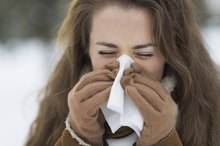What does fact checked mean?
At Healthfully, we strive to deliver objective content that is accurate and up-to-date. Our team periodically reviews articles in order to ensure content quality. The sources cited below consist of evidence from peer-reviewed journals, prominent medical organizations, academic associations, and government data.
The information contained on this site is for informational purposes only, and should not be used as a substitute for the advice of a professional health care provider. Please check with the appropriate physician regarding health questions and concerns. Although we strive to deliver accurate and up-to-date information, no guarantee to that effect is made.
Skin Rashes From Glutamine
Skin rashes from glutamine are the result of an allergic reaction to gluten. Glutamine is considered on of the most abundant amino acids, according to the University of Maryland Medical Center 1. It is commonly used by body builders as a supplemental protein. Wheat contains four major allergic proteins: albumin, globulin, gliadin and gluten, according to Food Allergy Initiative 2. People who have been diagnosed with a gluten or wheat allergy should not use glutamine 2. Talk to your doctor before you take any supplement.
If you are experiencing serious medical symptoms, seek emergency treatment immediately.
Cause
The cause of skin rashes from glutamine is the result of an allergic reaction to gluten. During an allergic reaction to glutamine, the immune system experiences hypersensitivity and overreacts to the protein. The immune system mistakes the protein as a harmful substance and creates IgE antibodies to ward off the glutamine. This begins a chemical reaction in the body that produces common allergic reaction symptoms.
- The cause of skin rashes from glutamine is the result of an allergic reaction to gluten.
- The immune system mistakes the protein as a harmful substance and creates IgE antibodies to ward off the glutamine.
Skin Rashes
Skin Rashes and Allergies to Soy
Learn More
Common skin rashes from a glutamine allergy are general itching, eczema and hives. A general rash can form that causes inflammation and itchiness of the skin after ingesting glutamine. An allergic reaction to glutamine can trigger eczema in a person pre-disposed to the skin condition. Eczema appears as blisters, typically on the face, arms and back of the legs. Hives form in clusters that are flat on top and have defined borders. Hives are extremely itchy and can form in various shapes and sizes.
- Common skin rashes from a glutamine allergy are general itching, eczema and hives.
- An allergic reaction to glutamine can trigger eczema in a person pre-disposed to the skin condition.
Contact Dermatitis Consideration
Contact dermatitis is inflammation of the skin that results in eczema-like blisters simply from touching a substance. If you are allergic to glutamine, it is recommended by the American Academy of Allergy, Asthma and Immunology that you avoid consuming and touching the product. Contact dermatitis rash symptoms will appear within a few minutes after touching glutamine.
Treatment
Soy Lecithin Allergy Symptoms
Learn More
Skin rashes from an allergic reaction to glutamine are best treated by identifying the allergen and then avoiding the product. If you accidentally ingest glutamine, call your doctor right away. Use topical steroid creams to calm the skin, reduce inflammation and itching, according to the American Academy of Allergy, Asthma and Immunology. Hydrocortisone is available over-the-counter and corticosteroids may be prescribed in severe cases. An oral antihistamine will help to reduce the amount of histamine in the body that is causing the rash breakout, according to MayoClinic.co 2m
- Skin rashes from an allergic reaction to glutamine are best treated by identifying the allergen and then avoiding the product.
Consideration
If you are allergic to wheat, you may run the increased risk of developing a severe allergic reaction when ingesting glutamine. A severe allergic reaction could be life-threatening. Common symptoms include a drop in blood pressure, a faint pulse, dizziness, anxiety and shortness of breath.
Related Articles
References
Writer Bio
Diane Marks started her writing career in 2010 and has been in health care administration for more than 30 years. She holds a registered nurse license from Citizens General Hospital School of Nursing, a Bachelor of Arts in health care education from California University of Pennsylvania and a Master of Science in health administration from the University of Pittsburgh.









